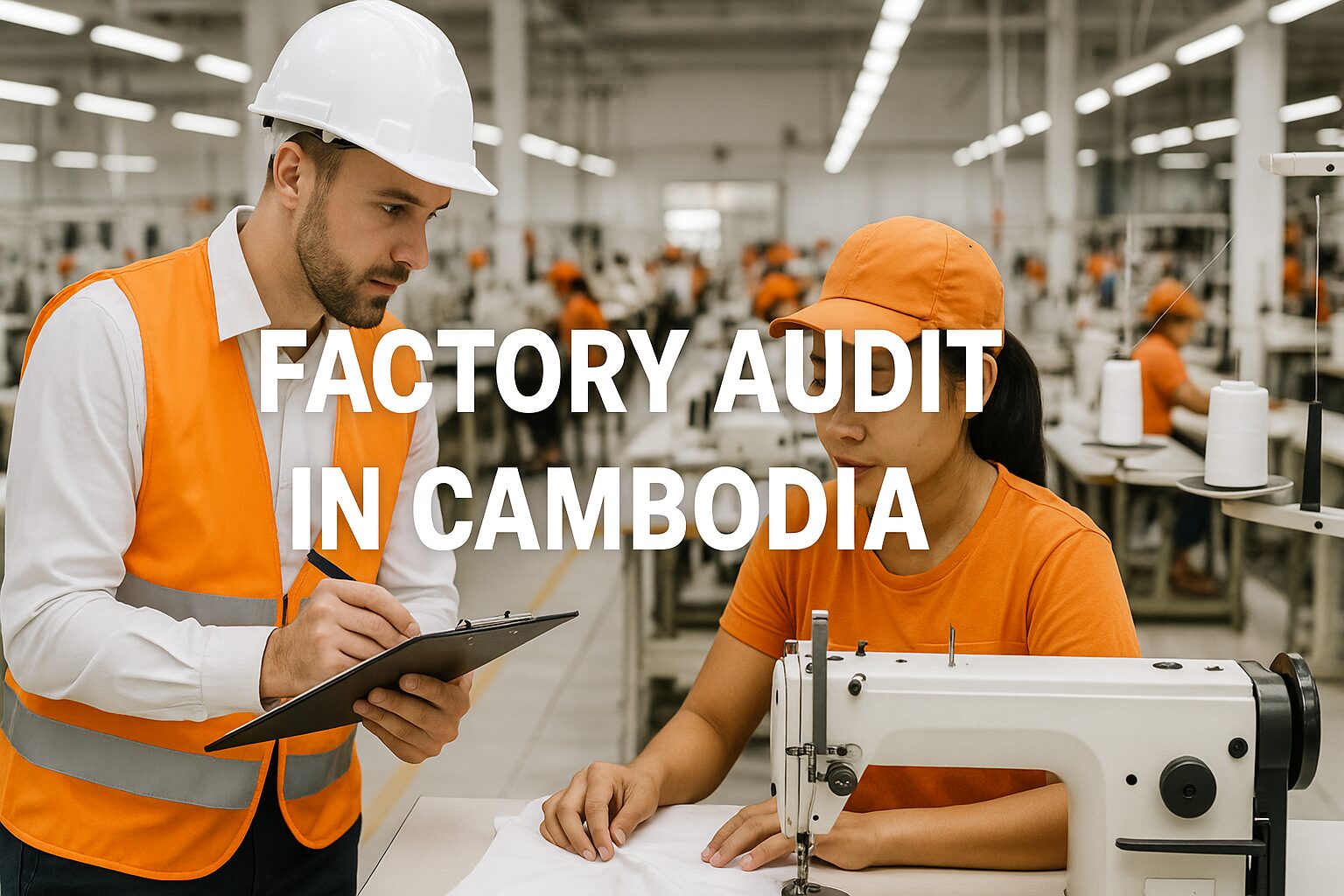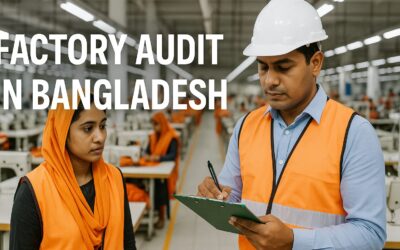If you’ve been sourcing from Asia, you’ve likely noticed Cambodia’s manufacturing scene growing at full speed. By mid-2025, the country had over 45,600 registered factories and enterprises, which is considered a very sharp rise from previous years.
Once known mainly for garments and footwear, Cambodia is now expanding into electronics, automotive parts, bicycles, and rubber processing. With this diversification, more global companies like ours are looking toward Cambodia as a reliable, cost-effective alternative to traditional manufacturing hubs.
But rapid growth also brings new risks, and that’s where factory audits come in. A proper audit gives you a clear view of a supplier’s capabilities, management systems, and compliance with international standards.
It helps you confirm that the facility meets your expectations before production even begins. Whether you’re evaluating a garment factory in Phnom Penh or a rubber processor in Sihanoukville, these audits make sure you’re partnering with trustworthy, qualified manufacturers.
More and more businesses are now turning to third-party inspection and audit providers for an unbiased look inside factories. These experts carry out facility qualifications, supplier evaluations, and compliance checks that protect your investment and reputation.
In this article, we’ll focus on how factory audits in Cambodia work, why they matter, and how they help you build stronger, more reliable partnerships in one of Asia’s fastest-growing manufacturing hubs.
What Is a Factory Audit in Cambodia?
A factory audit in Cambodia is a structured evaluation process that examines a manufacturer’s operational, technical, and ethical standards before production begins.
It helps you verify whether a supplier can meet your quality expectations, capacity needs, and delivery requirements.
In practice, a factory audit goes beyond a surface inspection. It reviews management systems, production lines, equipment maintenance, and documentation to confirm that processes align with international and local compliance standards.
These audits are typically performed by two types of evaluators: internal teams working directly for the buyer, or independent third-party auditors.
While internal audits help maintain ongoing supplier relationships, third-party audits provide an unbiased assessment of the factory’s overall reliability and risk profile. In Cambodia, this process has become essential for global companies seeking to prevent quality issues, labor violations, and supply chain disruptions.
Why More and More Businesses Are Sourcing from Cambodia
In recent years, Cambodia has emerged as one of Southeast Asia’s most dynamic manufacturing destinations. Its low labor costs, competitive trade policies, and improving infrastructure have attracted a growing number of international buyers.
The country’s manufacturing sector achieved a remarkable 9.7% year-on-year growth in 2024, signaling strong recovery and diversification after global supply chain shifts.
Garments, footwear, and travel goods (GFT) remain the country’s leading export categories, supported by a skilled workforce and well-established production zones.
However, Cambodia’s government has been actively promoting diversification into new industries such as automotive components, bicycles, electrical parts, and rubber.
This policy shift is drawing investors from Europe, North America, and Japan who seek both cost efficiency and emerging market opportunities.
As more brands turn to Cambodia for production, factory audits have become a necessary part of supplier selection. They help you confirm that the growth in quantity does not compromise quality, ensuring your partnerships are built on verified standards and trust.
Why Are Factory Audits Important in Cambodia?
Factory audits in Cambodia are essential for businesses that want to make confident sourcing decisions and reduce the risks that often come with manufacturing in emerging markets.
These audits play a crucial role in supplier vetting, helping you confirm that a factory’s operations, workforce conditions, and production systems meet international standards.
By assessing quality management, ethical practices, and facility conditions, audits act as an early warning system before production begins.
Without regular audits, it’s easy to overlook issues such as subcontracting, non-compliance with labor laws, or inconsistent product quality.
In Cambodia, where manufacturing capacity is expanding quickly, these risks can escalate if factories are not properly monitored. Regular audits that are conducted at least once a year, quarterly for high-risk or new suppliers, and immediately after any serious non-conformity, help ensure that your supply chain remains stable and transparent.
The benefits of conducting consistent audits include better supplier accountability, improved product reliability, and verified compliance with safety and ethical standards.
They also help you prevent fraud, verify corrective actions, and build long-term trust with your Cambodian partners.
What Common Quality and Manufacturing Risks Make a Cambodia Factory Audit So Important?
Although Cambodia’s manufacturing sector is expanding, certain risks make audits especially critical for importers and brands.
Before listing them, it’s important to understand that these risks vary by industry and supplier experience but often affect consistency and performance.
Major risks and concerns to watch for include:
- Narrow industrial base: Cambodia’s manufacturing ecosystem is still developing, which can limit access to specialized materials and skilled technicians.
- Dependence on imported materials: Many factories rely heavily on foreign raw materials, increasing exposure to delays, shortages, and fluctuating costs.
- Limited quality management systems: Smaller factories may lack formal quality control procedures or documented inspection processes.
- Labor compliance issues: Inadequate safety measures or excessive overtime can lead to ethical and reputational risks for global buyers.
- Infrastructure limitations: Transportation, logistics, and energy supply inconsistencies can impact production timelines and cost efficiency.
What Does a Typical Factory Audit in Cambodia Include?
A factory audit in Cambodia follows a structured sequence designed to evaluate a manufacturer’s operational, ethical, and technical performance. Each audit type focuses on specific aspects of compliance and performance that together provide a complete view of a factory’s reliability.
Here are the main audit categories typically included in a Cambodian factory assessment:
- Social Compliance Audit: Evaluates working conditions, employee safety, wages, and adherence to international labor standards. Common frameworks include SMETA, WRAP, and BSCI.
- Technical Audit: Examines machinery, production capacity, maintenance practices, and the technical know-how required to meet client product specifications.
- Ethical Audit: Reviews management transparency, fair treatment of workers, and prevention of forced or underage labor.
- Environmental and Fire Safety Audit: Checks compliance with BNBC-2020 and RSC standards on structural integrity, fire exits, electrical systems, and boiler safety.
- Security Audit: Focuses on access control, shipment protection, and anti-theft measures to prevent cargo-related risks.
- Facility Inspection: Provides a physical walkthrough of the premises, verifying layout, cleanliness, workflow, and material handling efficiency.
- Factory Verification: Confirms legal registration, ownership legitimacy, and that the factory’s identity aligns with the claimed business credentials.
How to Prepare for a Factory Audit in Cambodia
If you are a manufacturer, start by reviewing your internal documentation, including business licenses, safety certificates, and employment records. Ensure that workstations are organized, fire extinguishers and emergency exits are clearly marked, and quality records are up to date.
Assign a responsible manager to guide auditors through the facility and answer questions confidently.
If you are a buyer planning an audit, begin by defining the audit’s scope—whether it’s social, technical, or full compliance.
Gather previous reports, quality records, and supplier communication logs. Share your checklist with the audit team in advance so they can align their evaluation with your expectations.
Essential preparation steps include:
- Confirm the audit schedule: Agree on the date, location, and contact details for the inspection team and factory representatives.
- Review documentation: Prepare operating procedures, quality manuals, and certifications for easy access during the visit.
- Address previous findings: If a prior audit revealed non-conformities, document the corrective actions taken and provide evidence of improvement.
- Ensure factory access: Notify the staff of the audit in advance to prevent disruptions and ensure full cooperation.
What Happens During the Factory Audit Process?
The factory audit process in Cambodia follows a structured series of steps designed to evaluate a facility’s compliance, capability, and consistency.
Each stage provides vital insight into how a manufacturer operates and whether it aligns with your quality and ethical requirements. The goal is to identify potential risks before production begins, ensuring that you work only with reliable and transparent partners.
This is what happens during a factory audit;
- Opening Meeting: The audit begins with an introduction between the auditors and factory management. During this stage, the audit scope, schedule, and expectations are clarified.
- Document Review: Auditors assess essential records such as business licenses, quality manuals, employee records, and safety certificates to verify compliance.
- Facility Tour: A thorough walkthrough of production areas, warehouses, and worker facilities allows auditors to observe real operations and verify conditions.
- Interviews and Verification: Staff and management are interviewed to ensure policies, such as safety procedures or labor standards, are effectively implemented.
- On-Site Testing and Observation: Auditors may inspect machinery, test samples, or observe workflow to assess production efficiency and quality control practices.
- Closing Meeting and Reporting: The audit concludes with a discussion of findings, corrective actions, and timelines. A comprehensive report is then issued, outlining the factory’s compliance level and risk areas.
What Should You Do After the Cambodia Factory Audit?
Once your factory audit in Cambodia is complete, your next steps are crucial in turning the findings into actionable improvements. The post-audit phase helps you maintain accountability and strengthen supplier relationships through measurable follow-up actions.
Here’s what to do;
- Review the audit report: Examine every section carefully, noting both critical and minor non-conformities.
- Evaluate supplier performance: Compare audit results against your company’s compliance criteria and decide whether the factory meets your requirements.
- Develop corrective actions: Collaborate with the factory to address each issue. Set realistic deadlines and define responsibilities.
- Monitor progress: Request documentation, photos, or follow-up audits to verify that corrective actions are properly implemented.
- Update supplier records: Keep track of all audit results in your supplier management system for future reference and performance reviews.
How Often Should You Audit a Cambodian Factory?
You should conduct a factory audit in Cambodia at least once a year, though frequency depends on the supplier’s risk level, production complexity, and performance history. High-risk or newly onboarded suppliers should be audited quarterly, while established factories with strong compliance records can be reviewed annually.
The ideal audit schedule balances thorough oversight with operational efficiency. For instance, if you’re sourcing high-value or safety-critical products, more frequent evaluations help prevent costly errors. Industries dealing with complex assemblies or strict ethical requirements such as electronics or apparel, often benefit from semi-annual reviews.
If major non-conformities are discovered, a follow-up audit should occur immediately after corrective actions are completed. Regularly scheduled audits also allow you to track improvements, validate certifications, and confirm that your partners continue to meet evolving global standards.
How Much Does a Factory Audit in Cambodia Cost?
The cost of a factory audit in Cambodia varies based on the audit type, location, and complexity of the supplier’s operations. On average, a general audit designed to verify a manufacturer’s production capacity and compliance standards costs between $300 and $400. This price typically covers an on-site evaluation, document review, and final reporting. For companies that need deeper or more specialized assessments such as environmental, ethical, or technical audits, the cost can increase due to additional labor, testing, and extended audit duration.
At QCADVISOR, factory audits in Cambodia start at USD 280 per man-day, offering one of the most cost-efficient and reliable options for businesses sourcing in Southeast Asia. Travel expenses may apply depending on how far the factory is from major urban centers such as Phnom Penh or Sihanoukville. The overall pricing also depends on audit scope, the number of auditors required, and the supplier’s production scale.
What Are the Key Manufacturing Hubs and Industries in Cambodia?
Cambodia’s manufacturing sector is concentrated in several key regions, each serving a specific industrial role within the country’s growing production landscape. These hubs are supported by improving infrastructure, industrial parks, and government incentives that attract both local and international investors.
Main manufacturing hubs and their key industries include:
- Phnom Penh: The capital city is Cambodia’s industrial core, hosting factories that produce garments, footwear, packaging materials, and light electronics. It also serves as a logistics center for exports through the nearby Phnom Penh Autonomous Port.
- Sihanoukville: Located along the country’s southern coast, this area focuses on heavy manufacturing and export-oriented industries such as automotive components, rubber processing, and marine products. The Sihanoukville Special Economic Zone (SSEZ) is one of the largest in the region.
- Kandal and Kampong Speu: These provinces have become popular for garment and textile manufacturing due to lower land and labor costs while still maintaining proximity to Phnom Penh.
- Bavet (Svay Rieng Province): Positioned near the Vietnam border, Bavet’s industrial zones are known for electronics assembly, bicycle production, and footwear manufacturing, benefiting from strong cross-border trade.
- Poipet (Banteay Meanchey Province): This northwestern hub specializes in consumer goods, automotive parts, and machinery assembly, with strategic access to Thailand’s industrial corridor.
How to Select the Right Cambodia Factory for Your Business
Selecting the right factory in Cambodia requires more than comparing prices, you need to assess the factory’s capabilities, quality systems, and ethical practices before production begins.
To begin, you should evaluate the factory’s legal status, registration, and ownership structure. Confirming these details helps prevent fraud and ensures that your business is working with a legitimate operation. Next, request detailed information about the company’s production capacity, machinery, and workforce. Visiting the facility, either in person or through a third-party partner, allows you to verify these claims and gain insight into daily operations.
The factory audit is the most effective method to confirm compliance and capability. It provides an in-depth review of production systems, safety measures, and quality management. Following the audit, a product inspection ensures that finished goods meet specifications before shipping. Together, these steps reduce risks such as substandard materials, shipment delays, or non-compliance with international standards.
Should You Consider Third-Party Inspection Companies for Factory Audits in Cambodia?
Yes, you should always consider working with a third-party inspection company when conducting factory audits in Cambodia. A third-party audit is performed by an independent organization that specializes in evaluating manufacturing operations on your behalf. These firms provide an unbiased and professional assessment of a supplier’s compliance, technical capability, and ethical practices.
Cambodia’s Ready-Made Garment (RMG) sector, for example, is supervised by the RMG Sustainability Council, the successor to the Accord, which has established independent safety checks as a standard part of factory oversight. This framework has made third-party audits a common practice for international buyers.
Benefits of using third-party inspection companies include:
- Objectivity: Independent auditors provide impartial results, eliminating bias that may arise from internal reviews.
- Technical expertise: Professional inspectors are trained in evaluating production processes, safety standards, and documentation.
- Efficiency: External partners streamline the audit process, reducing the time needed to verify multiple suppliers.
- Risk reduction: Early detection of quality or compliance issues prevents costly production or shipment problems later.
- Global credibility: Verified audit reports from recognized firms help you meet international buyer and certification requirements.
QCADVISOR Factory Audit
QCADVISOR stands as a leader in supplier audits and quality control services across Asia. As an international team of inspection professionals, they provide comprehensive factory audits in Cambodia to ensure your supply chain meets the highest standards of performance, compliance, and transparency. Their mission is simple; to help you avoid scams, identify reliable partners, and maintain exceptional product quality from start to finish.
QCADVISOR offers a full suite of audit options, including Factory Verification, Technical Audits, Corporate Social Compliance Audits, and Customized Audits tailored to your business needs. Their auditors are available on-site within 48 hours, enabling rapid response to inspection requests. The process begins when you book your audit online, providing details about your project at least 48–72 hours before the scheduled visit.
Once your booking is received, QCADVISOR confirms the quotation, coordinates with your supplier, and prepares a detailed checklist tailored to your product category. The assigned auditor then conducts the inspection according to the agreed scope, addressing issues immediately when possible. A complete report is delivered within hours of the visit, offering a transparent overview of supplier performance and factory conditions.
With a proactive, technology-driven approach, QCADVISOR doesn’t just detect problems—it helps you prevent them. From raw material to finished product, their audits ensure sustainability, efficiency, and complete visibility into your Cambodian manufacturing operations.
Could You Conduct Remote or Virtual Factory Audits in Cambodia?
Yes, you can conduct remote or virtual factory audits in Cambodia using digital tools and live communication platforms. These audits are particularly useful when travel restrictions, post-COVID limitations, or geographic barriers make on-site visits impractical. Companies can now perform inspections through live video calls, real-time facility walkthroughs, and document sharing systems to evaluate compliance and quality without physical presence.
Remote audits often combine digital documentation, recorded footage, and assistance from third-party agents who act locally to verify details. This hybrid method ensures transparency and allows you to make informed sourcing decisions while saving time and cost.
With the QCADVISOR 360 Virtual Tour, you can visit your supplier’s factory from the comfort of your home or office. This immersive experience offers a realistic, interactive walkthrough of the facility, enabling you to observe operations, evaluate conditions, and make confident decisions, without stepping on a plane.
Conclusion
Choosing the right factory in Cambodia is about partnering with a company you can trust. Factory audits give you the confidence that what’s happening behind the factory doors matches what’s promised on paper. They help you see the full picture: quality systems, ethical standards, safety practices, and overall reliability.
Whether you’re walking the production floor in person or connecting through a virtual audit, the goal stays the same, transparency, consistency, and peace of mind. At QCADVISOR, we make that process simple. With tools like our 360 Virtual Tour, you can explore your supplier’s facility from anywhere, get real-time insights, and make decisions that protect your brand and your customers.
In the end, investing in a factory audit means investing in your business’s future. When you know your suppliers inside and out, you’re not just managing risks, you’re creating a stronger, more resilient supply chain that keeps you ahead of the curve.




